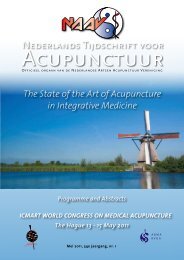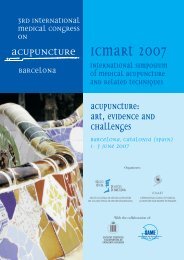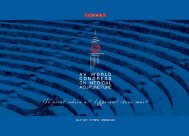Congress Abstracts full PDF - International Council of Medical ...
Congress Abstracts full PDF - International Council of Medical ...
Congress Abstracts full PDF - International Council of Medical ...
You also want an ePaper? Increase the reach of your titles
YUMPU automatically turns print PDFs into web optimized ePapers that Google loves.
Workshop 3<br />
‘VERY POINT’ THERAPY COMBINING POINTS OF VARIOUS MICROSYSTEMS, ESPECIALLY ORAL<br />
ACUPUNCTURE<br />
Jochen Gleditsch, Ludwig Maximilian University, Munich, Germany<br />
Irmgard Simma-Kletschka, Complementary and Alternative Medicine in Dentistry, Bregenz, Austria<br />
In the mouth, a system <strong>of</strong> very effective acupuncture points is to be found in the mucous membranes. These points<br />
act as reflex points in modern pain therapy. Mucosa points, in a state <strong>of</strong> irritation, have a high degree <strong>of</strong> sensitivity<br />
and therapy <strong>of</strong> these points proves highly effective.<br />
They are divided into vestibulum and retromolar points. Vestibulum points show the interactive relationship between<br />
teeth – odontoma – meridians and corresponding organs and systems <strong>of</strong> all five functional circuits.<br />
The five functional circuits are represented eight times in the oral somatotope.<br />
From the retromolar area in particular, immediate muscle relaxation <strong>of</strong> the cervical and chewing muscles can be<br />
achieved.<br />
Mouth acupuncture restores to normal the malfunctioning systems <strong>of</strong> the entire body.<br />
The effects take place immediately – especially with muscles and joint problems, mobility <strong>of</strong> the cervical spine, etc.<br />
Oral acupuncture is a regulatory therapy: remote effects are predictable.<br />
The exact localisation <strong>of</strong> the point is necessary – “Very Point”.<br />
In the peri-oral area corresponding points to the vestibulum points can be found in a state <strong>of</strong> irritation.<br />
Microsystempoints (YNSA, Lymphbelt, etc.) use the relaxing, sedative, local circulatory incease and analgetic<br />
effects as known in acupuncture.<br />
In Clinical studies mouth and microsystem acupuncture points have proved to be very effective, especially in<br />
patients with cervical and craniomandibular disorders.<br />
Examinations analysis and therapeutic records and study-designs will be presented.<br />
Workshop 4<br />
NEURAL THERAPY IN PRIMARY PAIN CARE<br />
Kurt Gold-Szklarski<br />
Austrian <strong>Medical</strong> Association <strong>of</strong> Neuraltherapy, Vienna, Austria<br />
In order to avoid the developement <strong>of</strong> chronic pain syndroms, malfunction <strong>of</strong> the locomotor system and pain are<br />
to be treated as soon as possible. An appropriate technique should be easy to apply, harmless, cheap and requiring<br />
little equipment. As NT satisfies all these claims and in addition guarantees to be without side-effects even when<br />
combined with any other method, it lends itself ideally for primary pain care.<br />
THE IMPACT OF NEURALTHERAPY IN IN- AND OUTPATIENT PAINTHERAPY<br />
W. Ilias, R. Janda, K. Wohak<br />
Austrian <strong>Medical</strong> Association <strong>of</strong> Neuraltherapy, Vienna, Austria<br />
The introduction <strong>of</strong> potent painkillers with new formulations <strong>of</strong> transdermal, intrathecal, transmucosal as well as<br />
oral fast resorption and slow release preparations, changed the approach to pain treatment in many aspects. Besides<br />
the development <strong>of</strong> new minimal invasive procedures such as ozonenucleolysis, high frequency and pulsed neurolysis<br />
as well, opened innovative possibilities for pain treatment with specific impact in low back pain. On the other hand,<br />
cure by means <strong>of</strong> trigger point injections <strong>of</strong> local anaesthetics has still clinical importance in treatment and diagnosis<br />
respectively. An analysis <strong>of</strong> outpatients treated in one year (2007) in our pain ambulance showed a still remarkable<br />
quantity <strong>of</strong> treatments which in general may be determined as neural therapy. Although the majority (92,3%) <strong>of</strong><br />
patients received pharmacologic treatment by means <strong>of</strong> oral or transdermal medication the second frequent treatment<br />
was trigger point injection and/or repeated nerve block or regional block (66,6%) for treatment or diagnosis as well.<br />
In 28% <strong>of</strong> the patients invasive methods such as ozon nucleolysis, or high frequency neurolytic blocks where<br />
performed. In 18,8% <strong>of</strong> the patients surgical procedures such as implantations <strong>of</strong> devices for intrathecal drug<br />
application spinal cord stimulation or subcutaneous stimulation had been used for pain treatment. The data show<br />
clearly that patients suffering on chronic pain need individual approaches such as combinations <strong>of</strong> pharmacological<br />
and invasive methods as well. When looking at the distribution <strong>of</strong> methods used in a standard pain ambulance, neural<br />
therapy is still the second important way <strong>of</strong> standardised treatments in chronic pain.<br />
44







